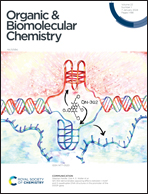A chloride-responsive molecular switch: driving ion transport and empowering antibacterial properties†
Abstract
A molecular switch was developed to recognize and transport Cl− across lipid bilayers. The XRD-crystal structure and NOESY NMR spectra of a potent 4-aminoquinazoline analogue confirmed Cl−-induced conformation changes. Systematic biophysical studies revealed that the quinazoline moiety forms cooperative interactions of H+ and Cl− ions with the thiourea moiety, resulting in the transport of H+/Cl− across the membranes. A pH-dependent analysis revealed that the transport of Cl− by the potent compound increased in an acidic environment. The potent compound could also transport H+/Cl− across Gram-positive bacteria, leading to antibacterial activities.



 Please wait while we load your content...
Please wait while we load your content...